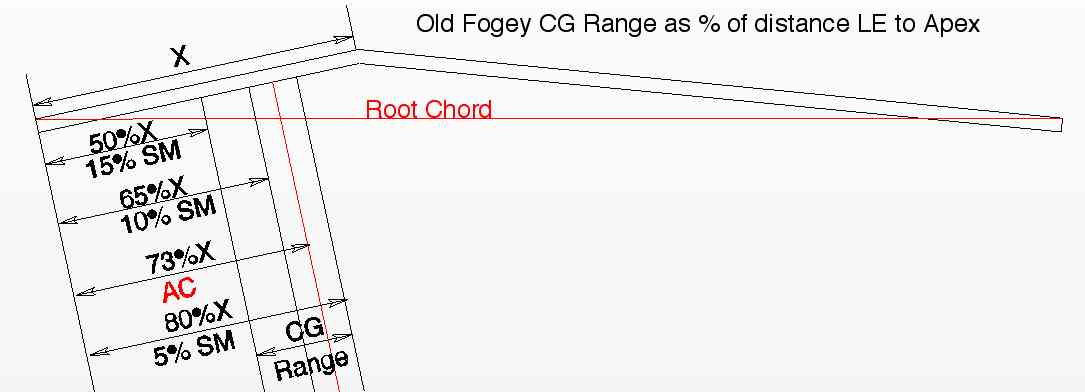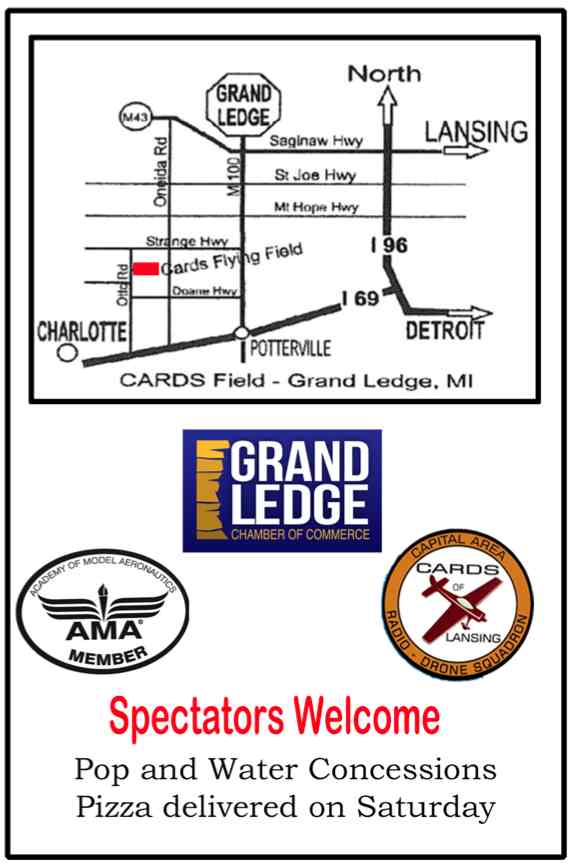 |
Flying High With Electric Power!
The Ampeer ON-LINE!
Fly the Future - Fly Electric! |
|---|
Site Table of Contents
| President: | Vice-President: | Secretary-Treasurer: |
| Ken Myers | Richard Utkan | Rick Sawicki |
| 1911 Bradshaw Ct. | 240 Cabinet | 5089 Ledgewood Ct. W. |
| Commerce Twp., MI 48390 | Milford, MI 48381 | Commerce Twp., MI 48382 |
| (248) 669-8124 | (248) 685-1705 | (2480 685-7056 |
 | ||
| Board of Directors: | Board of Directors: | Ampeer Editor |
| David Stacer | Arthur Deane | Ken Myers |
| 16575 Brooklane Blvd. | 21690 Bedford Dr. | 1911 Bradshaw Ct. |
| Northville, MI 48168 | Northville, MI 48167 | Commerce Twp., MI 48390 |
| (248) 924-2324 | (248) 348-2058 | (248) 669-8124 |
| The Next Flying Meeting: Date: Sat. & Sun., July 9 & 10 - the Mid-Am Time: 10 a.m.
Place: Midwest RC Society 7 Mi. Rd. Flying Flied | ||
| Warren Plohr Remembered Keith Shaw shares his thoughts about Warren Plohr. | Sid Kauffman Remembered information from Greg Gimlick. | |
| More on the Old Fogey's Old Fogies (Includes Power System Comparisons/EMAX & Cobra motors - EMAX ESC & CC Thunderbird) Ken shares his mods for the Mk II version and discusses the difference in the system efficiency between his two chosen power systems. | Upcoming Electrics' Over Lake Orion Electric Fly-in Electric Fly-in Announcement | |
| Upcoming CARDS Electric Fly-in Electric Fly-in Announcment | More on the Revolectrix Gt500 Charger & A Possible Problem with the RC Buddy Paraboard V3 Ken discusses his use of the charger and where to find information on a possible problem with the Paraboard V3 | |
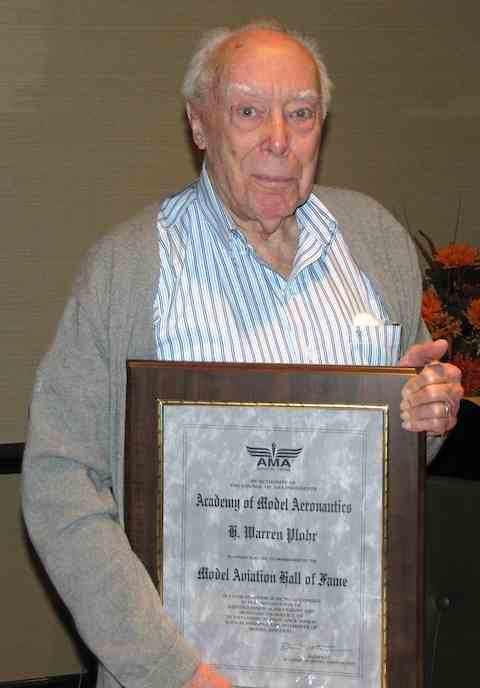
Info and photo from Keith Shaw I'm about to head out to Warren's memorial service, which reminded me of your request for info. I'm sending the official obit and my recollections of Warren over the 55+ years that I knew him. His quiet hints were very appreciated as I struggled to understand transistors. He never outright encouraged me, but he was the singular adult who didn't think it was crazy for a 12 year old to be designing his own R/C equipment. I owe much to Warren. I doubt if I would ever have been successful without his momentary nudges. Where would electric flight be? While growing up in Cleveland, I was fortunate to have known and flown with Warren, Chet Lanzo, Ted Blase, Thad Kusak, Al Seidowski, Warren Weisenbach, Herb Rindfleisch and many others who were highly influential in the history and development of model aviation. I learned so much from each one of them. I was fortunate to have known Warren for over 55 years, and our paths have criss-crossed several times. We both lived in Cleveland and flew at the same American Airlines model club field. He would patiently answer my questions about radio theory, and was the singular adult that didn't dismiss a 12 year old kid from designing and building his own radio control equipment. He was a big help in understanding transistor theory when I was working on my first smallish receiver. I had been flying homemade tube equipment, but transistors were much harder to understand. Later in 66-67 he answered my phone questions as I struggled to design my first successful digital proportional. He was flying homemade analog proportional when I first met him, in a curious lime green plane he called "The Green Monster". I remember several bolt heads that protruded out of the top of the window fairing just before the wing. They were circuit taps that he would check with a voltmeter before every flight. It had HUGE counterbalanced (and counter-weighted) control surfaces (R&E), and I remember him doing aerobatics in a very small space. Warren gave it to me recently and it is in my basement awaiting restoration. The covering is in tatters, so a complete strip is in order. Understand that green is my least favorite color, but I WILL finish it in the lime green as a fitting tribute to my respect for Warren. I plan on adding "Warren Plohr's Green Monster" in dark green script on the wing in his memory. I was fortunate to work for NASA-Lewis in Cleveland after graduating from college. Warren worked several buildings over and we talked modeling over lunch occasionally. We were both involved with a Saturday program that taught advanced classes for local hotshot high school students. I taught Digital Electronics, and Warren taught Aerodynamics if I remember correctly. I moved to Ann Arbor to pursue a Doctorate in Physics at The University of Michigan. I had lost touch with Warren for a good number of years until, wonders of wonders, he walked into an Ann Arbor Falcons meeting. He and Joan had moved to Ann Arbor to be closer to their daughter and grandchildren. Once again our paths had crossed, we flew together, and the friendship has continued. The nursing care facility that he and Joan were in was only two miles from my house, so I tried to stop in for a visit once a month. He enjoyed seeing my recent "nostalgia" single channel projects (using Phil Green's button encoder), and outright laughed and shook his head at my digital 2.4GHz Galloping Ghost rig. I owe a tremendous debt to Warren. I doubt if I would be flying today without his quiet encouragement. Keith Henry Warren Plohr, Aerospace Pioneer, passed away on March 29, 2016 at age 94, in Ann Arbor, Michigan. He shared 66 years with his love, Joan Perl Plohr, who passed away on September 19, 2015. Warren was born on March 17, 1922 to Anna Muller and Henry William Plohr in New York City. His childhood dreams were all about flying. He constructed countless model airplanes, taking the subway to fly them at Central Park. In December 1942 he enlisted in the United States Army Air Force, and became a B-24 Liberator pilot, flying 11 combat missions over Germany and France for the 489th Bomb Group. The war ended while he was training to pilot B-29s in the Pacific. He received an Air Medal for his combat service. Following the war, Warren studied aeronautical engineering at Carnegie Tech. He met his beautiful Joan in the college cafeteria. They married in Mansfield, Ohio, and moved to Cleveland for Warren's first job working in turbine aerodynamics at NACA's Aircraft Engine Research lab. In 1958 NACA became NASA and Warren began applying his aviation knowledge to the first US manned spaceflight, Project Mercury. He was a member of the Space Task Group, working on Big Joe, the first unmanned test vehicle. The first manned capsule was designed and assembled at Cleveland. Warren was a designer of the attitude control system for the Mercury capsule, which used high-pressure nitrogen thrusters to maneuver the capsule after separation. Another project was the design of the "gimbal rig", which tested an astronaut's ability to control the spacecraft in a vacuum. From 1966 to 1970 he managed the Agena, an upper-stage booster rocket used to launch spacecraft for NASA's planetary program. The Lewis Agena launch record was nearly perfect. Payloads included the Ranger, Lunar Orbiter, Mariner (Mars and Venus) and the Nimbus weather satellites. In the seventies he was the Chief of Spacecraft Technology at Lewis. He also led a NASA-sponsored Explorer Scout Post that introduced students to the engineering profession. Warren retired in 1979, and received the NASA Exceptional Service Award. Throughout his life Warren continued to build and fly gas and electric powered model aircraft. In the eighties he made model sailplanes, and served for 6 years as the vice president and president of the League of Silent Flight. In 1982, he completed the final Level V task - an 8-hour slope flight. In the nineties Warren served on the Academy of Model Aeronautics' Frequency Committee, working with the FCC to secure the MHz band set for radio-controlled models. He continued service on the Electronic Technical Committee through 2010, and was inducted into the Model Aviation Hall of Fame that year. Warren's love of flying brought him a wonderful circle of friends, as did his summers at his cottage at Lake Gage, Indiana. He is survived by his sister, Doris Hansen, and his three children: Bradley Plohr, Bonnie Upton (Ben) and Robert Plohr (Carol). He was so proud of his six grandchildren: Tate and Linus Plohr, Frederick, Samuel and Celia Upton, and Benjamin Plohr. Warren and Joan's family wish to thank the caregivers and staff at University Living and Compassus Hospice for the kindness and respect they provided to them. The life Warren led gave all who shared it a dignity and love for what good humans can do. Sid Kauffman Remembered
Greg and Dana, I have some very sad news to share with you. This past Tuesday (May 3, 2016) Sid Kauffman died of a heart attack. It was very sudden and unexpected but he passed quickly into Heaven. As you know he was an avid electric flyer, inventor (software and hardware) and an expert in the hobby. He will be greatly missed by many people, especially by me as he was my best friend. We both enjoyed going to the flying field to fly or to flying events up and down the east coast to watch other enjoy the hobby (NEAT, SEFF, Triple Tree, etc). His funeral will be this Saturday, May 7, at 1 PM at Westover Church in Greensboro. Bill Sellers I'm sorry to pass the news that ElectriCalc guru and extremely good friend Sid Kauffman passed away suddenly on Tuesday from a heart attack. If you've been to any big electric meet in the last 25 years, you've probably had his wife's excellent Shoe Fly Pie and a bottle of Cheerwine they always passed out in their pit. I think of Sid every week, as I still use his software regularly, to answer reader's questions as to setups. He will be sorely missed. Sid was a good friend, but even a finer man. Greg More on the Old Fogey's Old Fogies
The June 2016 Ampeer contained a lot of information about my version of the Old Fogey type plane. My version was designed with the mission being that of a primary, introductory, flight trainer. Its mission is to successfully introduce a person, who has absolutely no experience flying RC planes, to successful flying. It has worked out well in this mission. A beginning pilot, who was NOT qualified to solo on his own commercial trainer, soloed Ken's Old Fogey, after only a brief 'get to the know the feel of the plane in the air' introduction. He has flown it, completely solo, many times on his own since then, and he is still NOT qualified to solo on his commercial 'trainer'. Two beginning pilots, with no RC experience, have also flown the plane very successfully in the air. I did not use a buddy box with them. I seldom, if ever, had to take the transmitter from their hands during their many flights. I would call the design a mission success. As mentioned in the first article, the name I'm using for the plane came from Josh Bixler of Flite Test. Whether he 'coined' the name or not, I have no idea. Many planes can be found on the Internet and on YouTube that have the name Old Fogey or Old Fogey -ish or -like appended to their names. There are also planes that have 'borrowed designs' that are similar. Who 'borrowed' from whom, I cannot tell. They have different names, but apparent 'Old Fogey' lineage. 
Click on photo to visit the Hobby King Mariposa page. HobbyKing's Mariposa, constructed of balsa and lite plywood, seems very similar in design and is flown and compared to the FT Old Fogey on YouTube by the Flite Test folks. 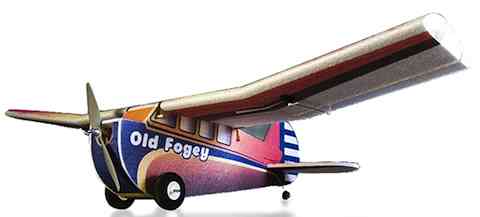
Click on photo to visit the Hobby Old Fogey page. To confuse matters a bit, Hobby King also has a plane, made of EPP foam, that they call the Old Fogey. It is clearly much closer in linage to a Clancy Lazy Bee. 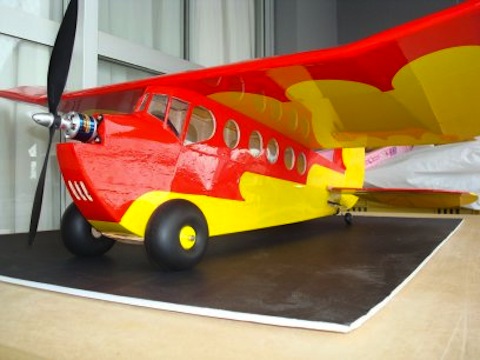
Clancy Lazy Bee  Buddy RC also has an EFO foam version called the TechOne Lazy Flyer. Again, its lineage appears to be more Lazy Bee than Old Fogey. For me, the most Old Fogeyish, commercially available ARF, is the Mariposa. The bottom of the fuselage is horizontal, the horizontal stabilizer is on the bottom of the fuselage and the plane 'sets up' on the landing gear. My second version of the Old Fogey included several refinements over the prototype. The battery hatch hinge was changed as well as using Velcro to hold the hatch closed. The magnets, used on the prototype did not work well in the DTFB. A 1/16" plywood plate was added to the bottom of the fuselage, where the landing gear are rubber banded to the fuselage. Velcro was used on the bottom of the battery tray to hold the Velcro battery strap in place. The template/plans were improved to make joining of the fuselage sides to the fuselage bottom more accurate. A commercial, Sensei main landing gear, was used instead of what I just had laying around. 1/16" plywood control horns were tried, but they didn't work out well, so they were replaced by Great Planes Large Nylon Control Horns (GPMQ3901) 1-1/8" Long, which were also used on the prototype. 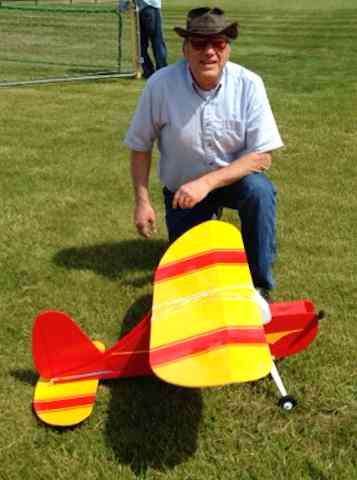 The most noticeable difference is the red and yellow EconoKote used to cover the Mk II. While the covering makes the plane a bit more durable, it also made it slightly heavier in the tail, and a bit of lead had to be added at the front end of the battery compartment. The strapping tape hinges for the battery compartment, elevator and rudder, used on the prototype, were not needed. The EconoKote was used for hinging. Both versions:
Prototype:
Mk II:
*Flying weight varies slightly depending on the specific 3S 1000mAh LiPo battery used. 3S 1000mAh LiPo batteries are used in both versions. The prototype used a Cobra C-2217/20 and Castle Thunderbird 36 amp ESC. It was a very good choice. With the same type of batteries, the EMAX GT2218/11 combined with the EMAX Simon Series 20 Amp ESC power system proved to be a disappointment. The default timing on the EMAX 20A ESC was 150. This gave an *apparent raw Kv of 1060. When run with either an APC 10x5E or APC 11x5.5E prop and a 3S 1000mAh pack, the efficiency was quite poor, compared to the Cobra/Thunderbird 36 combination. I was able, using the programming, available via the transmitter (what a pain), to change the timing to 00 in the EMAX 20A ESC. That produced an apparent raw Kv of 965. When the Thunderbird 36 was used, the apparent raw Kv was 930. The Cobra/Thunderbird 36 system yielded an apparent raw Kv of 900.
The timing for the Castle Creations Thunderbird is not noted, and it is not adjustable. The table presents the apparent raw Kv for no load measurements taken with 3S and 2S LiPo battery packs. The table also demonstrates why sometimes, the Kv noted by the manufacturer doesn't seem correct. The ESC's timing plays an important part in both the motor's apparent Kv and the system's efficiency. 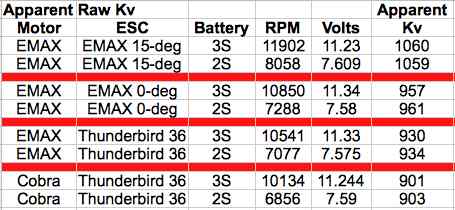 All of my collected data, from the various motor and ESC combination testing, was put into Drive Calculator. The following tables, for APC 10x5E and 11x5.5E props, show the various combinations with the same battery and the same prop selections in Drive Calculator. These are Drive Calculator SIMULATED numbers, but they are based on the real numbers collected during my motor testing. It is very easy to see why I will not be using EMAX motors or ESCs again. 
Win = power in Wout = power out  Several things are apparent in the tables. Efficiency of the system with a given load, the chosen prop, is based on the combination of the motor AND the speed control, the system efficiency. The chosen battery also has an affect on the total system efficiency, but is only generalized in these examples. Efficiency goes down as the ESC timing is increased. Yes, the RPM and power out increases with the timing, but at the cost of efficiency. While I had used the APC 10x5E at first, I changed to the APC 11x5.5E for the majority of the flights before reviewing the table information. The tables made me 'rethink' the prop selection and I tried the APC 10x5E on both planes with both power systems. The APC 10x5E works well with both planes and they fly just fine. Using the 10x5E also keeps the batteries, with either system, just a little above 3.7V resting per cell after six minutes of timed powered flight. After the motor and battery testing, the Cobra/Thunderbird 36 combo was installed in the Mk II and the EMAX motor and a Castle Creations Thunderbird 54 was installed in the prototype. I had a T-bird 54 in the drawer, so I put it to use. The EMAX 20 amp ESC was placed in the trash, where it belongs. It was expected that the EMAX 20A ESC would be less efficient than the Thunderbird 36. Size matters, but the weights of the two units were very similar in ready to use weight. Measured weights with connectors:
The CC Thunderbird 54, used to replace the EMAX ESC, weighed 48.5g/1.71 oz., ready for use. Cobra C2217/20 (14 pole), motor wt. 73.6g/2.6 oz., RTF wt. 82g/2.9 oz., Diameter 27.7mm, Length 32.6mm
The diagram illustrates the fore and aft center of gravity (CG) range. It can be used for any true Old Fogey version with similar proportions, including the original FT version. The diagram is a cross-sectional view of the wing profile. SM is static margin, a percentage of the mean average chord (MAC). An initial safe center of gravity (ISCG) range is between the AC (wing's aerodynamic center) and 10% SM (static margin), 65%X to 73%X. 1.) Overall dimension change is 1.22 times larger
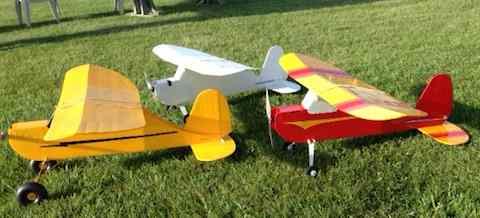
Norm Peters' Old Fogey (yellow) is in the foreground Norm Peters, of the Midwest RC Society, liked flying my Old Fogies so much, he created his own. He used the FT plans, which he enlarged, photos and dimension changes from my Old Fogies and the CG change. His version ended up slightly larger than mine, uses an E-Flite 480 power system, and it is very successful, for him, as a primary trainer. 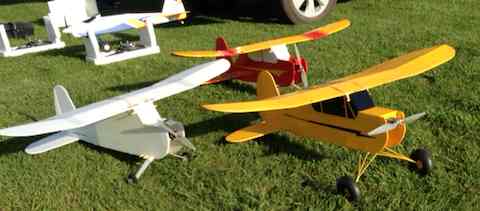
The Old Fogies Multiply - will it never end? Upcoming Electrics' Over Lake Orion Electric Fly-in Saturday, June 25, is the Electrics' Over Lake Orion Electric Fly-in. It is scheduled to run from 10 a.m. to Midnight at the Skymasters' Flying Field near Lake Orion, MI. There will be a potluck dinner at the field, bonfire, and NIGHT FLYING. Camping is allowed overnight at the field with open flying on Sunday. There is No Landing Fee and lots of parking. Refreshments are available at the event. There are Pilots' prizes. The flying field is located in Bald Mountain Recreation Area, about 5 miles north of the Palace of Auburn Hills, on Scripps Rd. between Lapeer Rd. (M-24) and Joslyn Rd. All vehicles require a Recreation Passport, which is available from the Michigan Secretary of State or the DNR. For more information email Pete Foss.
Upcoming CARDS Electric Fly-in On Saturday, August 27, the CARDS (Capital Area Radio Drone Squadron) present their 6th Annual Electric Fly-in from 9 a.m. to 9 p.m. The CARDS flying field is located at 8328 Otto Rd., Grand Ledge, MI, 48837. The event is open to all RC electric fliers that have proof of current AMA membership. Planes, multi-copters and helicopters are all welcome. The flying field features the best two runways in Mid-Michigan. The field will be available to registered pilots for electric only open flying on Friday, Aug. 26 from 3 p.m. to 9 p.m. There are pilot prizes and a raffle on Saturday. The landing fee is $15, which includes pilot pizza and soda. For more information contact the CD, Marv Thomson, phone 517-802-7675 or email Marv. There will be a pop and water concession.
Return to "What's In This Issue" More on the Revolectrix Gt500 Charger &
I reviewed the Revolectrix Gt500 charger in the May 2016 Ampeer. I have had a chance to use it a lot now, and I like it very, very much, and highly recommend it. It does have a couple of very small issues. Like ALL devices equipped with a LCD screen, it is difficult to read the screen in direct sunlight. The solution is simple, don't charge in direct sunlight. The charger defaults back to the last used setting. This is good, in some ways, but a little annoying at times. I only charge A123 and LiPo batteries with this charger. To make it easier to switch back and forth between the two, I have set up presets for both types of batteries. Selecting the appropriate preset, it is very easy to switch between the two chemistries. Problem solved. When charging my 3S 1000mAh LiPo batteries, I parallel charge them using the Buddy RC Paraboard V3. There has been a discussion thread started on RC Groups. It discusses some possible issues regarding all packs not balancing together on the Paraboard V3 as well as the MPA parallel charging boards. I have not seen this 'problem' with my Paraboard V3, but I only charge 3S 1000mAh packs at very similar states of discharge. To Reach Ken Myers, you can land mail to the address at the top of the page. My E-mail address is: KMyersEFO@theampeer.org |
